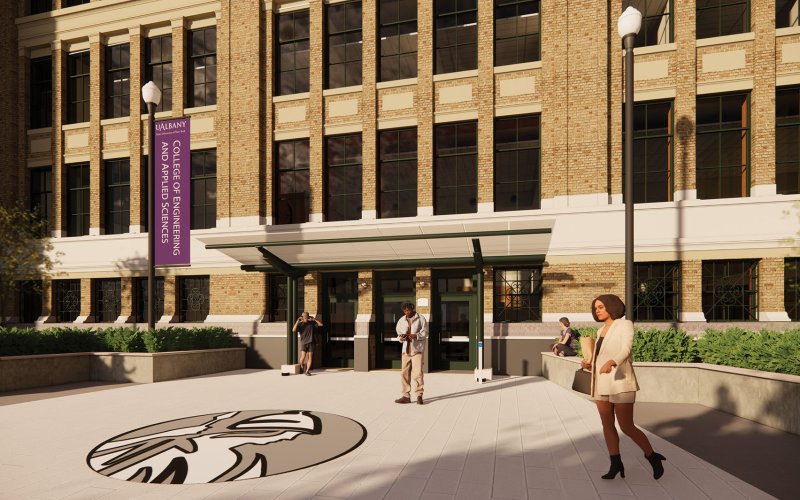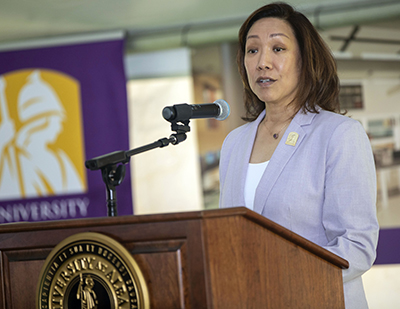Albany AI: Transforming the Academic Landscape

ALBANY, N.Y. (June 23, 2022) — With the launch of the Albany Artificial Intelligence Supercomputing Initiative (Albany AI) this week, the University is gearing up to prepare its students to find careers in a world where AI holds a ubiquitous role in society.
A $200 million public-private initiative based out of UAlbany's College of Engineering and Applied Sciences (CEAS) building — a neo-classical landmark built in 1912 that was formerly the home of Albany High School — Albany AI was lifted by $75 million in the 2022-23 state budget, which funds the completion of renovations to the CEAS building as well as the construction of a new supercomputer capable of harnessing massive data sets to facilitate next-generation AI research.
The launch event, attended by state and local government leaders including SUNY Interim Chancellor Deborah F. Stanley, was hosted by UAlbany President Havidán Rodríguez.
Artificial intelligence (AI) involves the development of technologies that are capable of performing tasks that normally require human intelligence. From smart phones to search engines, AI has become so commonplace that it is both an afterthought and a critical partner in our daily lives.
Through Albany AI, the University will advance research in such areas as cybersecurity, weather prediction, health data analytics, drug discovery and next-generation microchip design. But Albany AI will also involve important teaching and research collaborations with faculty in the humanities, social sciences, public policy, public health and social welfare, as well as the STEM fields, as AI increasingly touches all facets of daily life.
At the launch, UAlbany Provost and Senior Vice President for Academic Affairs Carol H. Kim discussed how AI instruction will be integrated into an undergraduate's educational experience.

"We are going to start out with a microcredential model," said Kim. "For example: Say you are a student majoring in Art History. You would begin with a foundational course in AI that would be designed for all majors. Next, you would take a module geared toward the arts and humanities... Finally you'd take a course specific to your discipline — in this case Art History+AI."
Dubbed Albany AI+X, this model holds the potential to lead to a host of new academic opportunities, including certificates, minors and eventually majors.
"This is going to give our students a critical edge that they won’t be able to find anywhere else," said Kim. "And this is going to help make them the most competitive candidates for any internship, any job, or any graduate or professional program that they pursue after graduation."
Among the top priorities of the Albany AI initiative is the transformation of the former Albany High School into a state-of-the-art engineering college and the construction of the first university-based supercomputer capable of a quintillion computations per second.
The completion of the engineering building, which will house Albany AI-related programs, is a critical step in the endeavor.
The renovation will transform the 110-year-old former Albany High School on UAlbany’s Downtown Campus into modern labs and classrooms while preserving its core architectural elements. The revitalization of the vacant 129,000-square-foot building at Western and North Lake avenues is a major investment in midtown Albany, which UAlbany has called home for more than century.
"We are thrilled that we will be able to preserve this beautiful building and ensure it serves midtown Albany for another century," said Rodríguez. "UAlbany's investment in this building is not just a vote of confidence in our home city but an example of how we can lead with our teaching, research and our commitment to our community."
Meanwhile, housed within the University's Uptown Campus Data Center, the Albany AI supercomputer will make computing clusters and exploratory hardware with the latest chip designs available to government, industry and university scientists across New York and beyond.
“This research requires a massive amount of computing power to process large volumes of data to arrive at conclusions that, for example, weather forecasters and emergency managers can trust,” said UAlbany’s Vice President for Research and Economic Development Thenkurussi Kesavadas. “Albany AI will provide the state-of-art, high-speed computational power needed to design the latest generation of semiconductors and to train and deploy new AI algorithms and machine-learning systems that will transform our approach to learning and fuel innovation.”
From building cutting-edge data tools to creating academic programs at the forefront of a critical emerging field, Albany AI holds the potential to dramatically increase New York's capacity in AI research and education.




